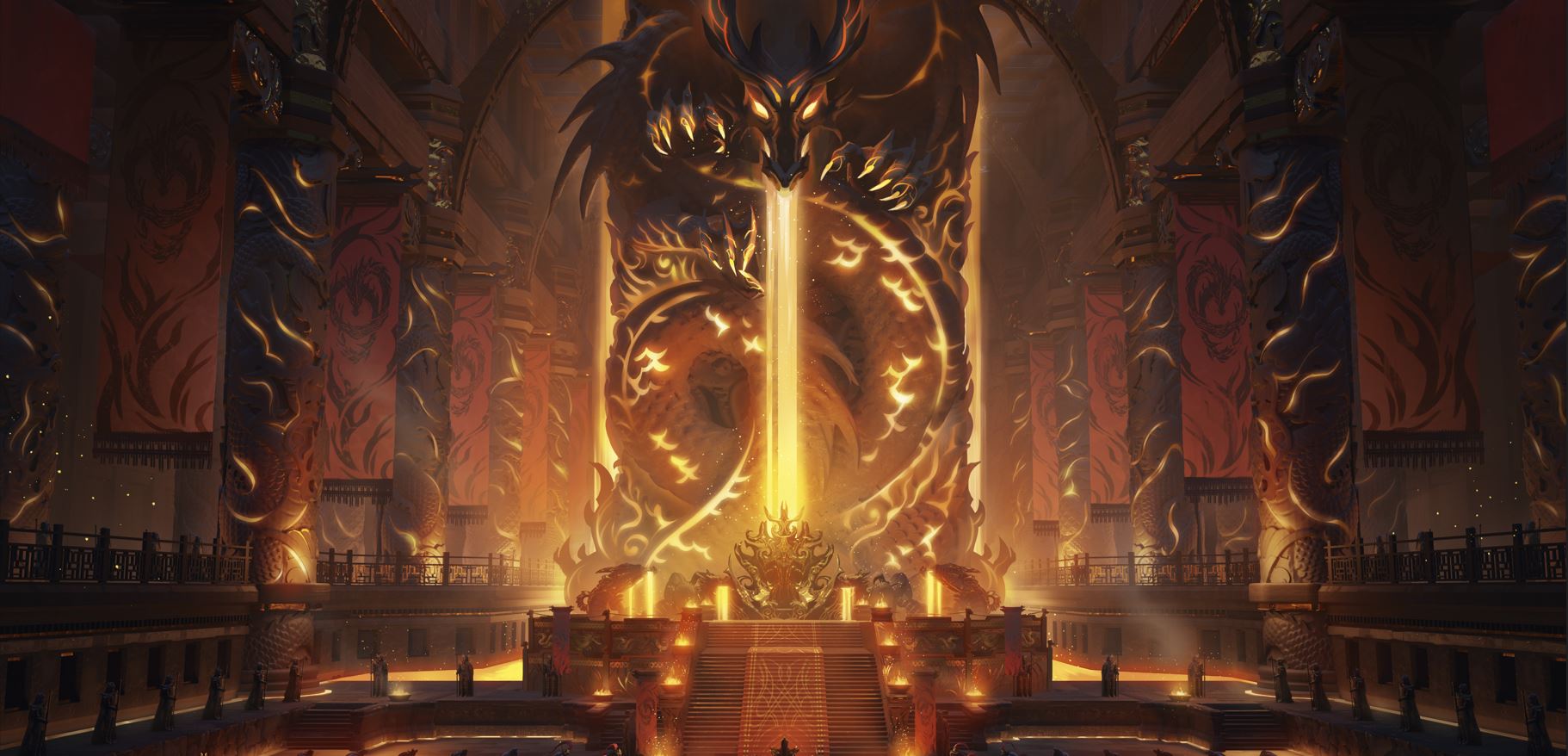From a humble launch on the eve of a global pandemic to the lead up to its first World Championship just a week away, Flesh and Blood celebrated its third anniversary earlier this month. The seeds of the game were planted long before it went into development in 2012, as its creator, James White, grew from a kid in a local game store to a world-traveling competitive card gamer to a national distributor in the trading card game (TCG) industry. When White started the daunting task of creating his own TCG, he already had more than 15 years of experience in the gaming world. White saw more games rise and fall than he could count in those years, so it was only fair that when Flesh and Blood debuted, it was met with both excitement and skepticism. While many were surprised to see Flesh and Blood succeed, White was not.
White and Legend Story Studios, the studio behind the game, always had the big picture in mind: bringing people together in the flesh and blood through the common language of playing great games on a global level. As Flesh and Blood moves into its third year, the game is being played in more than 3,000 stores throughout 38 countries. The game’s first World Championship is slated for November 3-6 in San Jose, California and its eighth expansion, Dynasty, is set to release the week after that. The goal and intention from the start was for the game to shake up the industry with a return to what made TCGs great. With White’s background and lifetime of experience in the TCG world, it’s easy to see why he isn’t surprised to see the game thriving.
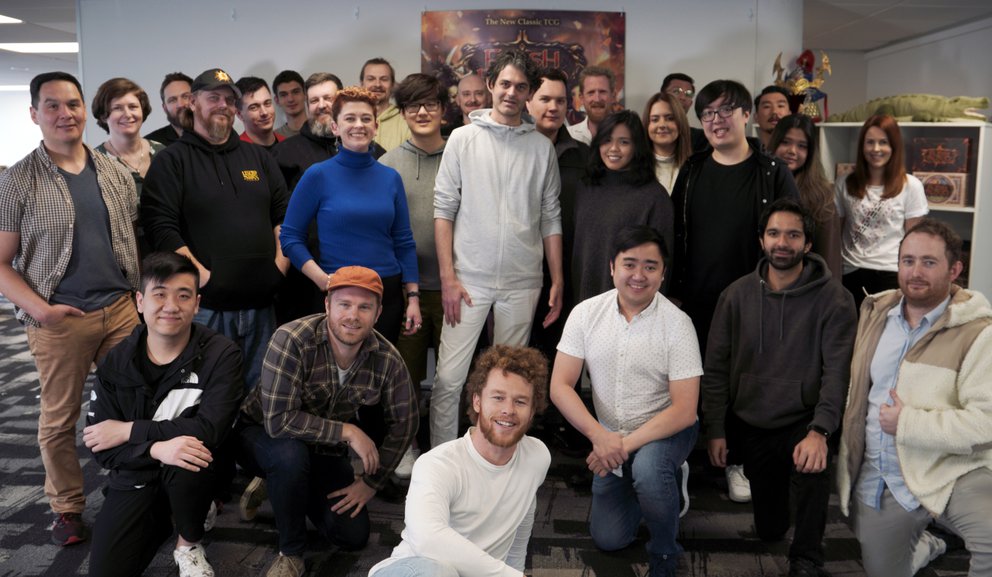
White’s journey from a competitive player, to in-store programs and judge programs organizer, to distributor has given him and his team the tools to develop the game of Flesh and Blood. This also includes creating the surrounding infrastructure of organized play, a deep IP suite, knowledge of supply chain distribution, marketing, and community management. Over the years, he saw the direction the industry was heading, shying away from in-person play to digital clients, and that didn’t sit well with him.
“As a young person, I grew up in my local game store. That was my roots — my anchor that kept me on track and introduced me to friends that I otherwise wouldn’t have made,” White said. “It opened up opportunities to travel around New Zealand and the world, and to broaden my horizons. It was such an important part of my life, and I really wanted to proactively do something to preserve that culture.”
According to White, the fundamental and most basic core of Flesh and Blood is keeping alive the concept of playing in-person at the local game store level and seeing the world through gaming. In order to make sure the game could do that, LSS had to make sure Flesh and Blood had a robust game system that could set it up to stand the test of time. They had to create a world and story arc to integrate into the gameplay and the products. That’s where the seven years of development came into play.
Creating and honing the resource system and key game mechanics took time — lots of it. White estimates he put in more than 10,000 hours of development before the game launched. He was joined by a number of people in that journey, many of whom had worked with him in his previous endeavors in the industry.
“I literally would play Flesh and Blood every single day for seven years,” White said. “We took so long developing it because we wanted to make sure the game had legs and that it had enough design space to elegantly evolve over time. I was very fortunate to have very great people around me.”
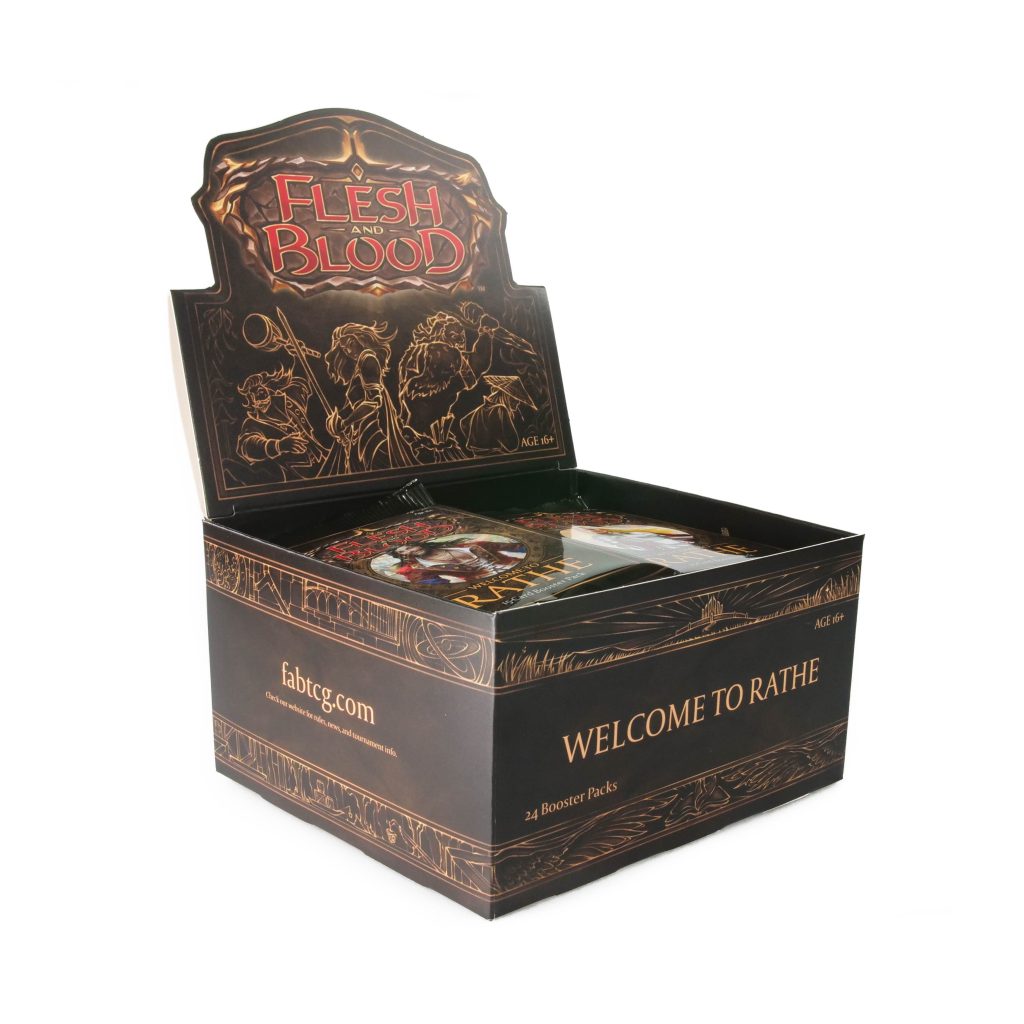
After working on the game since 2012, LSS launched Flesh and Blood in October 2019 with its first set — Welcome to Rathe. A few months later, the world shut down as COVID-19 put a halt on any public gatherings. For a game dependent on playing in-person, social distancing and self isolation were completely contrary to everything it was about. While gearing up for the game’s second set, Arcane Rising, New Zealand went into lockdown.
White said that global pandemic was terrifying and he feared it would kill the business. Things were so dire, LSS even put together a contingency plan of going into hibernation for a year and half and trying to relaunch the game again a couple years down the line. Fortunately, the community rallied together and LSS was able to continue to get its product into the homes of fans initially in the United States, and then across the world. LSS had to change its strategy, as public events were not on the table. By rolling out webcam-based organized play, players could still participate in events ran by stores from the comfort and safety of home. Two full Skirmish seasons were completely enabled through webcam play, with LSS shipping out prizes all over the world from their studio in Auckland.
The game stayed afloat thanks to webcam play. As COVID vaccines emerged, the return of tabletop play followed. A Calling in Las Vegas, the first one in North America since the end of 2019, kicked off a rejuvenated organized play circuit in the US on September 10-12, 2021. The event drew 750 players and was backed up with Callings in Dallas, Cincinnati, and Orlando over the next two months. A full Nationals season also returned.
Things continued to trend upward for Flesh and Blood OP this year with the first two Pro Tours, 11 Callings, a plethora of Battle Hardened events, and another round of National Championships. The game continued to spread to other countries and grew in popularity thanks to History Pack 1, a set of reprints produced in four other languages. More than 30 countries were represented at the Pro Tours in New Jersey and France.
Next week’s World Championship brings competitors from 38 countries together and boasts a $300,000 prize pool, with $100,000 going to the winner. The World Championship is expected to draw around 2,000 people, with only about 15-20 percent of the players participating in the titular event. Having a majority of the players in attendance doing things other than the main event, like meeting guests and artists, playing side events, cosplaying, or just jamming games with friends, delights White.
“An important message I want to get out there is that our big marquee events like Pro Tours and the World Championship have something for everyone,” White said. “Even if it is your first time playing, we have a welcome arena at the World Championship, where people can play their first ever game of Flesh and Blood. We have all of the support and resources in place to walk you through the Ira Welcome Deck all the way to have a great time.”
For the roughly 250 players that are qualified for the Flesh and Blood World Championship, mastery of Classic Constructed, Blitz, and Uprising Draft will be required. The Classic Constructed format is in a great spot, with 10 of the 16 legal heroes securing at least one win during Nationals season. While Oldhim, Grandfather of Eternity had the strongest performance during Nationals, the banning of Pulse of Isenloft evened the scales a bit. Iyslander, Stormbind was the most played hero at the Columbus Battle Hardened on October 22, but failed to reach the Top 8 of the 132-person event. Even Azalea, Ace in the Hole managed to Top 4 the event, showcasing how open the field is at the moment.
White also said that Blitz looks to be healthy, as community and developer feedback is mostly positive. Players appear to be happy with the slight changes to the format to keep it from being too aggressive. Uprising Draft is the only format not met with a glowing reception, but White attributes that to the fact it has been drafted to death at this point. The set was released at the end of June and has been used in Callings and the Pro Tour in Lille, leaving it relatively solved at this stage of its lifespan. LSS wants the World Championship to require broad excellence of the game, and that includes booster draft, so the format will be featured once again. White has taken note and will plan future Pro Tours and World Championships with booster draft in mind, in particular, how deep into the season the format is.
On top of the World Championship, card preview season for Dynasty kicks off on Monday. The set was originally meant to come out at the start of October to impact the World Championship, but like almost every game in the world, manufacturing and supply chain issues delayed the release. And with Flesh and Blood mainly being printed by Cartamundi in Belgium, the war in Ukraine, surging energy prices, and disruption to material imports like paper pulp has caused further constraints. So, instead of releasing Dynasty right before the World Championship and causing headaches for players, the set will drop on November 11.
A few cards have already been previewed from the official Dynasty announcement article, including a card for the Emperor, the central figure from the Uprising story. The set also brings back Marvels, a special cold foil variant for select cards that debuted in Uprising, with the first one being Crown of Dominion. The Marvels this time around will be called Relics of War and represent items found in the trophy room of the Imperial Palace. The Imperial Warhorn item looks to be a card for Ultimate Pit Fight, the Flesh and Blood multiplayer format.
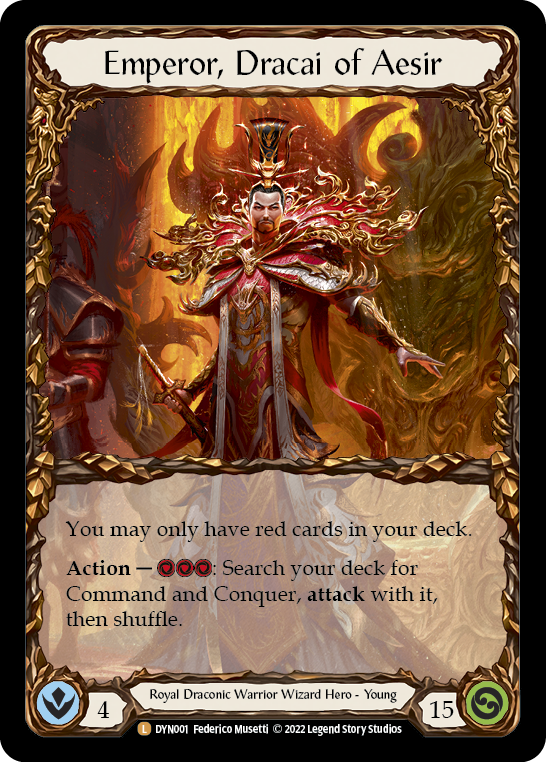
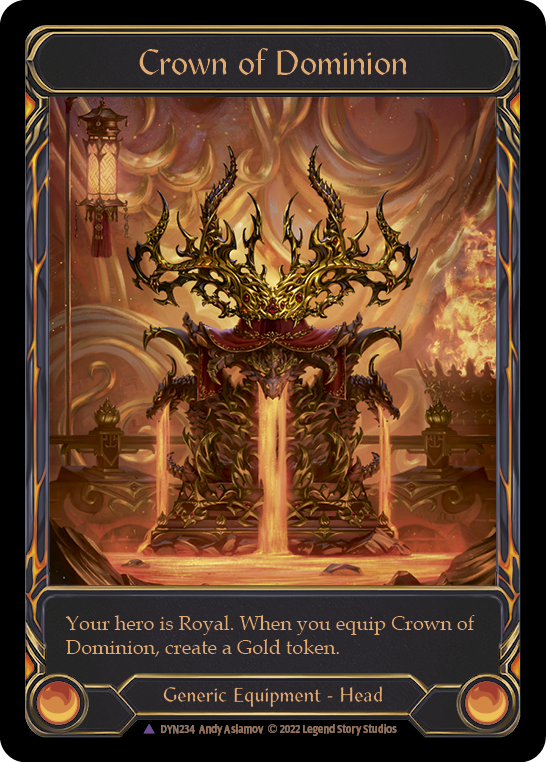
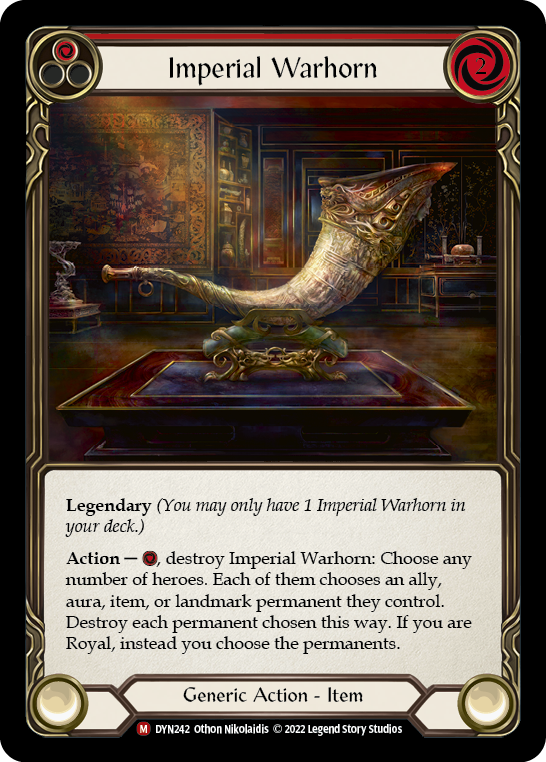
A Marvel version of Emperor, Dracai of Aesir will appear in one of 10,000 booster packs, making it the second rarest card that can be opened in a pack in the history of Flesh and Blood. Cold foil copies of Heart and Fyendal from the alpha edition of Welcome to Rathe and Eye of Ophidia from the first edition of Arcane Rising are tied for the rarest card that can be opened from a pack. White explained that the Relics of War offered the design and creative team a way to show off more history of the Emperor and his dynasty.
“Part of the storytelling for Dynasty is we wanted to take fans inside the Imperial Palace. What is a dynasty? A legacy or blood line that has existed a number of generations. So, we wanted to capture that through the Relics of War, being these trophies that the Imperial family has amassed and collected over the duration of their reign,” White said. “By taking the fans inside the trophy room we can show these different iconic or significant relics that they had somehow collected — whether gifted or plundered — from their conquests over the period that they held power.”
The storytelling will continue next week as lore and previews roll out in full. Check back with Star City Games on Monday for the reveal of one of the marquee majestics for the new class introduced in Dynasty and more of White’s commentary on the set.

